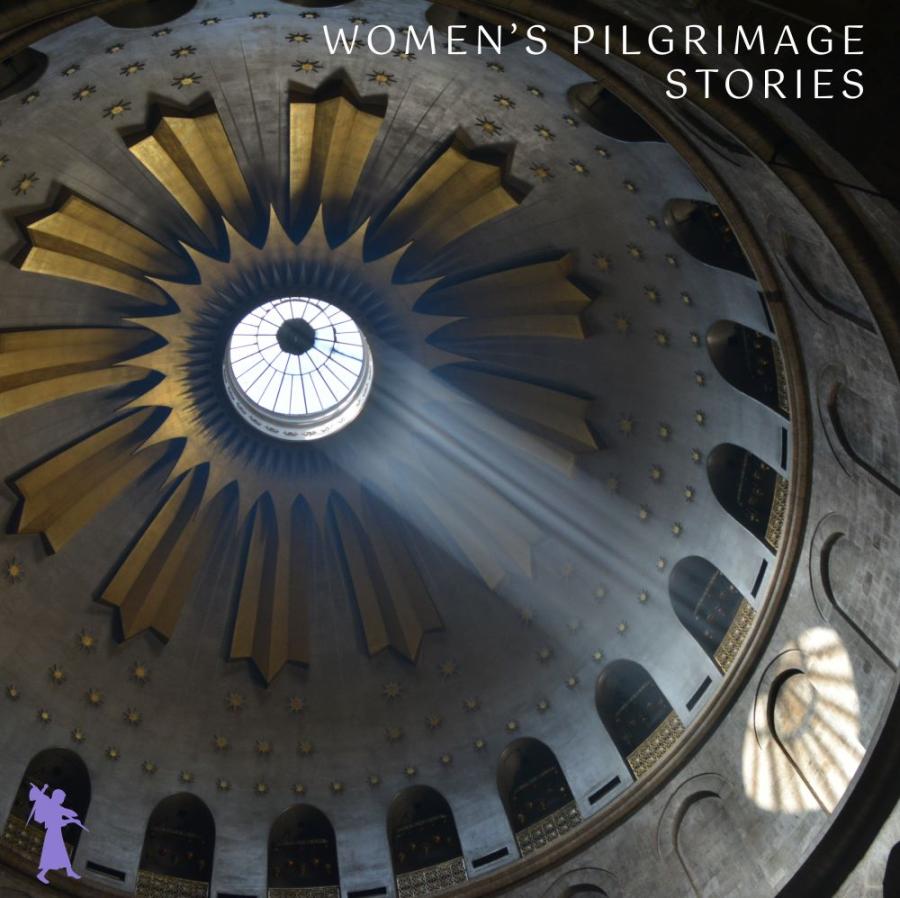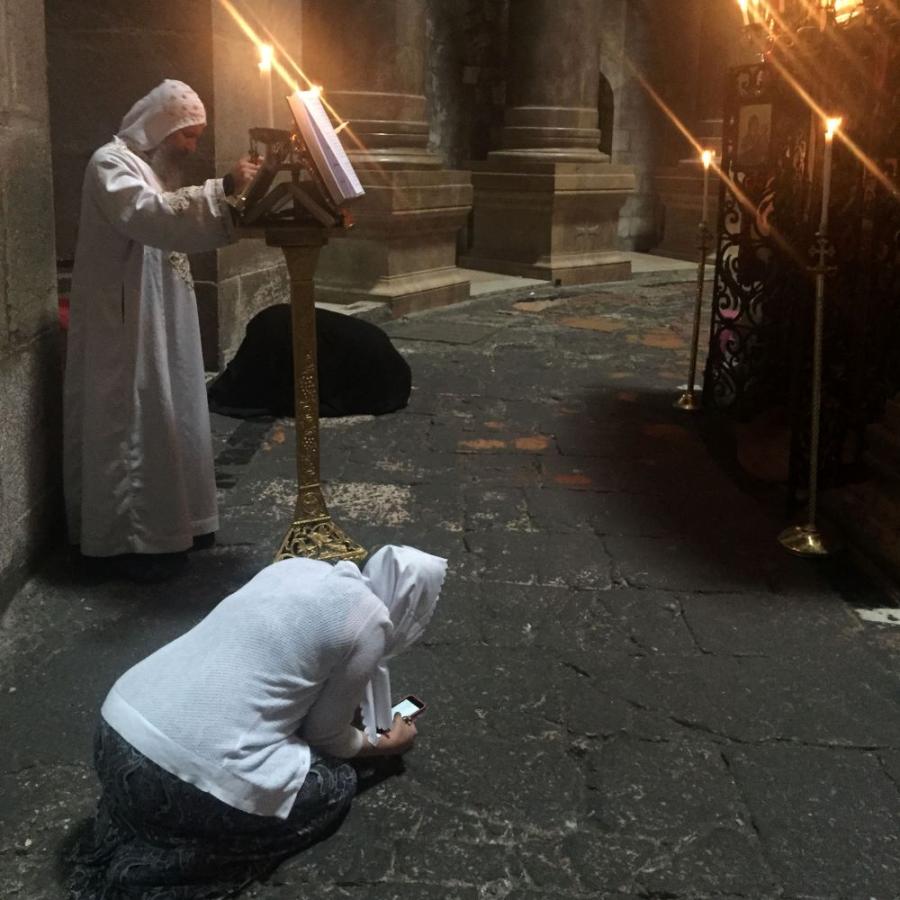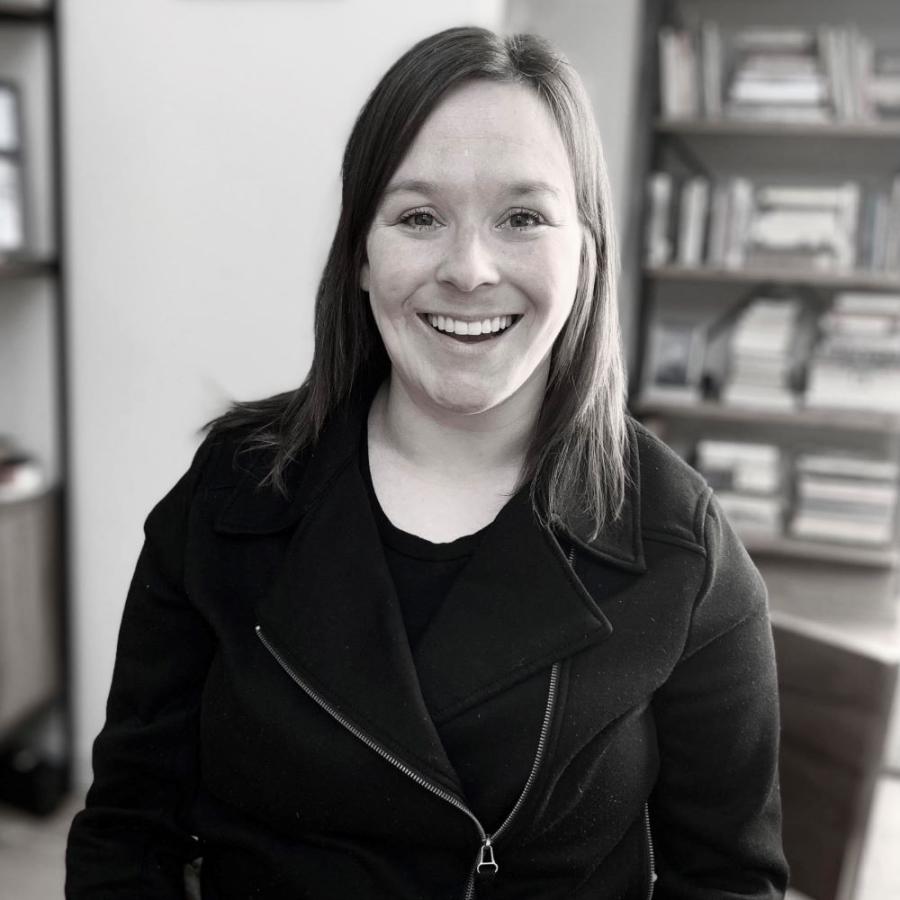
Dark and blessedly cool outside, I stepped out of my friend’s car at 4:30AM onto the empty cobblestone street outside the Church of the Holy Sepulcher. I blinked sleep from my eyes and gazed in wonder at the now-quiet holy site. The baking daytime sun of July in Israel had this Northerner exhausted and crowds in the daytime felt overwhelming - there were so many other pilgrims like me taking time to pray at the place of Jesus’ crucifixion and kneel at His tomb. Being here in the early morning to pray the Divine Liturgy felt as if I’d stepped back in time. I was excited and a bit nervous, because while I knew the Coptic chapel was tucked at the base of Jesus’ tomb, I didn’t know how we would pray there. What would it look like? Walking into the silent holy space, I walked into one of the most precious experiences of the Divine I have ever known in my life.
It had taken me a long time to convert to Coptic Orthodoxy. I was everything Western, a social liberal, a feminist, a skeptic, a scholar who placed reason and logic above mystery and courage. In some ways, I’m still those things, but my experience in Jerusalem changed me that day.
As an historian, I am in love with old things. I treasure each stone, every human-made chisel mark, every brush stroke on every icon. When I stood on the hard, cool stones at the Coptic chapel that morning, I felt energy buzzing through me. Who knows from where this energy came. I felt it in many forms; the hard thrum of millions of pilgrims’ feet, moving toward Christ’s tomb in adoration, and in the light vibrations in my heart, of the ancestors who fought to keep this holy place for future generations, whose prayers echo, silent but loudly, in the church.
The priest began prayers in Arabic, a language I do not speak. I felt again that hum in my chest, the familiar chants and tunes, helping me discern where we were in the prayers. This priest never said a word to me during our time alone together, not even greeting me before prayer. Perhaps he thought I was lost, in the wrong place. As a reserved Minnesotan, I was reticent about interrupting his prayers, and quietly prayed with him when he switched from Arabic to Coptic chants.
It was just a room with a tomb. A place and space. What made it holy? How did it make me a pilgrim? I had journeyed from Minneapolis to Jerusalem, sure, but my pilgrim excitement was found in praying in this historical spot, and my spiritual excitement in praying in the Coptic chapel, RIGHT BEHIND Jesus’ tomb, seemed unreal. It felt, and still feels, like the privilege of a lifetime. How could this priest pray here in this hallowed space every day without falling on his face before God? I know God is everywhere, and in all consecrated churches, and yet this place felt exceptionally holy. How could that be?
Jerusalem, the city in which Christ was sentenced to death, the place of his ultimate humiliation and embarrassment, has become a precious touchstone for all of us who believe in His resurrection. The site of his death has become the site of his victory over death. The tomb is empty! We, like the disciples, get to go in and see Christ’s absence for ourselves! Is this why the church feels super-charged, markedly sacred?
As the first hour of liturgy passed, another priest and some nuns arrived. This second priest smiled and identified himself to me. I pointed to the spot I thought we were, and he happily nodded. We didn’t speak each other’s languages and yet God had brought us together in a sort of mini-Pentecost, able to understand one another. Rather than an isolated experience, this priest offered me inclusion and community in our shared prayers. One of my favorite facts is that a priest in our tradition cannot offer up liturgical prayers without another person present. We do not worship or pray in isolation. Even in our prayers in the little churches, our homes, or even in our cars, are joined to those of the saints. Here in pilgrimage prayers, I found communion.
We continued to pray and a monk ran in, obviously late and a bit disheveled. He was tying on his hood. In my heart I thought, “Yes, here is one I understand.” Though a Westerner and former Lutheran, I have never been punctual, one of my near-fatal flaws. My heart went out to this young man, knowing that had not my incredibly punctual evangelical Christian friend dropped me off at exactly 4:30am, I would have more likely arrived running in like this monk. “We are kindred,” I thought, as he joined in the prayers. Finding communion, friendship, and love for strangers in this holy place gave the experience another layer of sacrality.
I was nervous to partake of the Holy Mysteries because I had only recently been baptized into the faith. Culturally, white Westerners are an understandably suspicious presence in a church of all Egyptian worshippers. There is always a possibility that a Coptic priest might question whether a white woman like me is Coptic Orthodox, because they want to protect the Eucharist and ensure non-Orthodox visitors aren’t partaking of something they do not yet fully understand or perhaps even find theologically acceptable.
As I walked up to partake in the Eucharist, the silent priest who had not acknowledged my presence over three hours of prayer said to me, “Are you baptized? Are you Orthodox?” I stuttered, “Yes, yes, baptized, yes Orthodox.” “Coptic Orthodox,” he asked? “Yes, yes.” I had taken a photo of my baptismal certificate to show him in case I needed it, but I had set my phone down to receive Holy Communion. This was one of those mental face-palm moments for me. A little reluctantly, he decided to trust me (or at least, Christ in me!), allowing me to partake of the Holy Mysteries. I was elated! Such joy I felt that morning and recall deeply within me since. There weren’t enough people to finish partaking of the holy Body and precious Blood, so we had to go back to the feast for seconds and even thirds! I realize that this experience is often commonplace for deacons but was not something I had done. I felt like the richest woman in the world, having gotten to partake in Christ’s supper with such lavishness, such abundance! I felt spiritually fortified in a new way, even though I know the smallest jewel of the Eucharist carries the same Christ. What participation in the sacred!
Little did I know, during this time, one of my dearest friends had taken a photo of me praying prostrate during the liturgy. It has become one of my favorite photos, a tiny snapshot of joyful participation in the divine. Kneeling prostrate before Christ on those hard stones was one of the best moments of my life. I treasure every twinge I felt in my knees and every kiss I laid on the floor as I prostrated myself. What a pleasure and privilege to meet Christ in this place, the place marking His victory over death.
My journey into Orthodoxy and to this little chapel took years and has never ended. My life is a continuous pilgrimage. I haven’t stopped visiting and finding holy places. This pilgrimage, though, remains number one in my heart.


Elizabeth Staszak is a convert to the Coptic Orthodox Church. She has an MDiv from Fuller Theological Seminary, an MA in Religion from Claremont Graduate University and a BA in History from St. Norbert College. Elizabeth is passionate about encouraging women in the church to exercise their spiritual gifts. Her areas of research are women in religion, Orthodox Christianity, and the intersection of Disability Studies and Theology.


